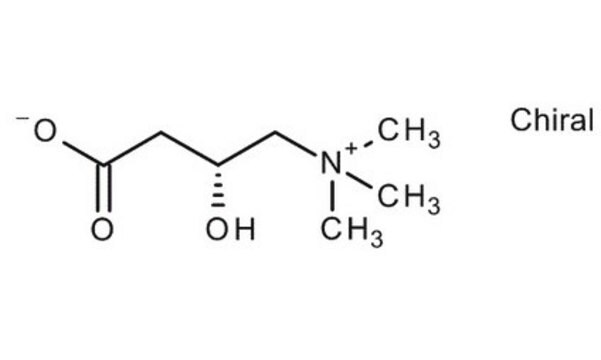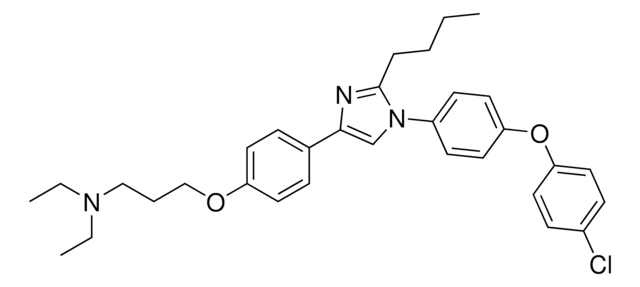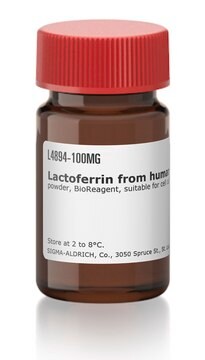E8780
Epiregulin from mouse
recombinant, expressed in E. coli, lyophilized powder, suitable for cell culture
Sinónimos:
EREG
Iniciar sesiónpara Ver la Fijación de precios por contrato y de la organización
About This Item
Número MDL:
Código UNSPSC:
12352200
Productos recomendados
recombinante
expressed in E. coli
Nivel de calidad
Ensayo
≥97% (SDS-PAGE)
Formulario
lyophilized powder
mol peso
predicted mol wt ~5.5 kDa
técnicas
cell culture | mammalian: suitable
impurezas
endotoxin, tested
Nº de acceso UniProt
temp. de almacenamiento
−20°C
Información sobre el gen
mouse ... Ereg(13874)
Acciones bioquímicas o fisiológicas
Binds and activates the tyrosine kinase ErbB family receptors (ErbB1-ErbB4). Inhibits the growth of several epithelial tumor cells and stimulates the growth of fibroblasts and other cell types. Its expression is upregulated in a number of carcinoma cell lines.
Forma física
Lyophilized from a 0.2 μm filtered solution in phosphate buffered saline containing 0.5 mg bovine serum albumin.
Nota de preparación
Recombinant Mouse Epiregulin is produced from a DNA sequence encoding the mature mouse epiregulin protein sequence. The protein is expressed in E. coli.
Epiregulin is a member of EGF (epidermal growth factor) family. All members of the EGF family are synthesized as transmembrane precursors and converted to soluble forms by proteolytic cleavage. Epiregulin was originally purified from the mouse fibroblast-derived tumor cell line NIH3T3/T7. Mouse epiregulin cDNA encodes a transmembrane precursorof 162 amino acids with a mature soluble form consisting of residues 56-101. Epiregulin acts like other EGF family members by binding to and activating the tyrosine kinase ErbB family receptors (ErbB1-ErbB4). Epiregulin has a broad specificity, but this ligand seems to preferentially activate heterodimeric receptor complexes. Epiregulin inhibits the growth of several epithelial tumor cells and stimulates the growth of fibroblasts and other types of cells. Its expression is upregulated in a number of carcinoma cell lines. Epiregulin is also an autocrine growth factor in human epidermal keratinocytes, and involved in the early stages of pregnancy, regulating the attachment of the blastocyst to the uterine epithelium during the implantation process.
Epiregulin is a member of EGF (epidermal growth factor) family. All members of the EGF family are synthesized as transmembrane precursors and converted to soluble forms by proteolytic cleavage. Epiregulin was originally purified from the mouse fibroblast-derived tumor cell line NIH3T3/T7. Mouse epiregulin cDNA encodes a transmembrane precursorof 162 amino acids with a mature soluble form consisting of residues 56-101. Epiregulin acts like other EGF family members by binding to and activating the tyrosine kinase ErbB family receptors (ErbB1-ErbB4). Epiregulin has a broad specificity, but this ligand seems to preferentially activate heterodimeric receptor complexes. Epiregulin inhibits the growth of several epithelial tumor cells and stimulates the growth of fibroblasts and other types of cells. Its expression is upregulated in a number of carcinoma cell lines. Epiregulin is also an autocrine growth factor in human epidermal keratinocytes, and involved in the early stages of pregnancy, regulating the attachment of the blastocyst to the uterine epithelium during the implantation process.
Nota de análisis
The biological activity is measured by its ability to stimulate the 3H-thymidine incorporation in a mouse fibroblast cell line, Balb/3T3.
Código de clase de almacenamiento
11 - Combustible Solids
Clase de riesgo para el agua (WGK)
WGK 3
Punto de inflamabilidad (°F)
Not applicable
Punto de inflamabilidad (°C)
Not applicable
Equipo de protección personal
Eyeshields, Gloves, type N95 (US)
Elija entre una de las versiones más recientes:
¿Ya tiene este producto?
Encuentre la documentación para los productos que ha comprado recientemente en la Biblioteca de documentos.
K Hashimoto
Journal of dermatological science, 24 Suppl 1, S46-S50 (2001-01-04)
Various kinds of growth factors are involved in the regulation of human keratinocyte function. Among them, the epidermal growth factor (EGF) family and the transforming growth factor-beta (TGF-beta) family play central roles, providing dual-mode regulation of keratinocyte growth through the
H Toyoda et al.
FEBS letters, 377(3), 403-407 (1995-12-27)
A cDNA clone encoding a novel epidermal growth factor (EGF)-related growth regulator, epiregulin, was isolated from a cDNA library prepared from a mouse fibroblast-derived tumor cell line, NIH3T3/clone T7. The predicted amino acid sequence revealed that the purified epiregulin peptide
Jian-Bo Fan et al.
Molecular and cellular biochemistry, 398(1-2), 105-113 (2014-09-17)
Epidermal growth factor (EGF) receptor (EGFR) emerges as an essential molecule for the regulating of osteoblast cellular functions. In the current study, we explored the effect of epiregulin, a new EGFR ligand, on osteoblast functions in vitro, and studied the
K P Karey et al.
Cancer research, 48(14), 4083-4092 (1988-07-15)
A completely serum-free assay method has been used to compare the mitogenic activities of polypeptide growth factors and estrogens with MCF-7 and T47D human breast cancer cells in culture. The lines were maintained in a viable, slowly dividing condition in
Teresa Elo et al.
Endocrine-related cancer, 21(4), 677-690 (2014-06-19)
Estrogens contribute to the development and growth of the prostate and are implicated in prostate tumorigenesis. In their target tissues, estrogens mediate their effects via estrogen receptor α (ERα (ESR1)) and β (ERβ (ESR2)). Hyperplasia and decreased differentiation of epithelial
Nuestro equipo de científicos tiene experiencia en todas las áreas de investigación: Ciencias de la vida, Ciencia de los materiales, Síntesis química, Cromatografía, Analítica y muchas otras.
Póngase en contacto con el Servicio técnico





